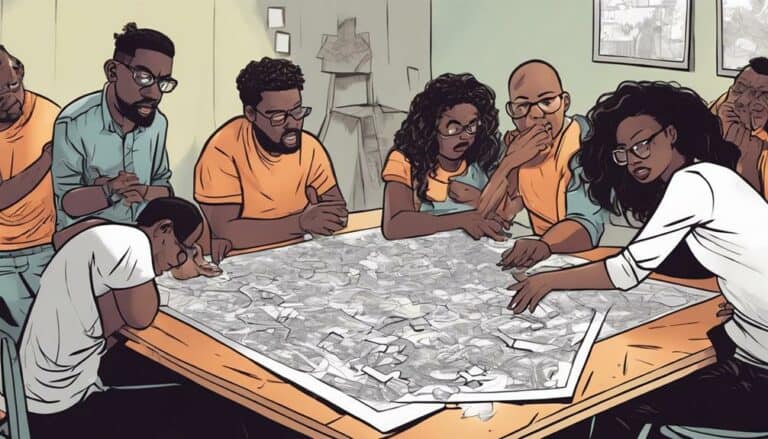When implementing team building workshops, you might think that resistance to change could be a considerable challenge. However, by acknowledging this potential obstacle, you can pave the way for a discussion on how to navigate through it effectively.
From addressing lack of participation to overcoming communication barriers and managing team dynamics, leaders encounter various hurdles. Understanding these challenges and exploring practical solutions is essential for fostering a cohesive and productive team environment.
By delving into strategies to tackle these obstacles head-on, you can set the stage for successful team building initiatives.
Key Takeaways
- Boost participation with engaging exercises and recognition.
- Address resistance through clear communication and incentives.
- Enhance communication for improved team dynamics and productivity.
- Manage time effectively with proactive planning and clear prioritization.
Lack of Participation and Engagement
To guarantee the success of team building workshops, addressing the challenge of lack of participation and engagement is essential for fostering team cohesion and productivity. One of the primary team building challenges is ensuring active participation from all team members. To overcome this obstacle, incorporate interactive and fun exercises that cater to diverse interests and preferences within the team.
By aligning activities with what engages employees, you can boost participation levels and create a dynamic environment for team cohesion to flourish. Additionally, recognizing and rewarding active participation during workshops can serve as a powerful motivator for team members to engage more enthusiastically.
Soliciting feedback from participants post-workshop is equally important. This feedback loop allows you to gauge the effectiveness of the activities, understand what resonated with the team, and make informed adjustments for future workshops. By prioritizing participation and engagement through tailored activities, recognition, and feedback mechanisms, you can lay a solid foundation for enhancing team cohesion and overall workshop success.
Resistance to Change and New Activities
Resistance to change and new activities often arises from a fear of the unknown and a sense of comfort with the current state of affairs within team building workshops. Addressing this resistance requires strategic approaches to encourage buy-in and participation. To overcome resistance effectively, consider the following:
- Clear Communication: Make sure that team members understand the benefits of the new activities and how they contribute to achieving team goals.
- Input and Involvement: Provide opportunities for team members to give their input and be actively involved in the planning process to increase their engagement.
- Leadership Support: Demonstrate visible support and active participation from leadership to motivate team members and show the importance of the workshops.
- Incentives: Offer incentives or rewards for active participation in team building activities to enhance motivation and encourage buy-in from team members.
Communication Barriers Within the Team
How do communication barriers impact team dynamics and productivity within team building workshops? Communication barriers can greatly hinder the effectiveness of a team, leading to misunderstandings, conflicts, and decreased productivity. When team members face challenges in openly communicating with each other, it can result in role ambiguity and ultimately impact the overall team performance during workshops. Leaders often face the task of addressing these barriers to make smooth collaboration and successful outcomes. By promoting open communication channels, encouraging regular team meetings, and utilizing collaboration tools, leaders can help bridge the communication gaps among team members. Conflict resolution strategies, such as active listening and providing constructive feedback, play an important role in overcoming communication barriers within the team. These efforts not only enhance team dynamics but also contribute to a more productive and efficient team building workshop environment.
| Challenges | Solutions | Benefits |
|---|---|---|
| Poor communication | Encourage open communication channels | Clear misunderstandings |
| Role ambiguity | Regular team meetings and collaboration tools | Defined roles |
| Decreased productivity | Conflict resolution strategies | Improved team performance |
Time Constraints and Scheduling Difficulties
Communication barriers within the team can greatly impact the dynamics and productivity of team building workshops. A new challenge that leaders may encounter is managing time constraints and scheduling difficulties. When faced with conflicting schedules, limited time, and varying work hours, balancing work priorities for team building workshops becomes essential.
To overcome these challenges effectively, leaders should engage in proactive planning, maintain flexibility in scheduling, and guarantee clear communication to prioritize team building activities. Here are some key points to take into account:
- Conflicting schedules and availability of team members can pose challenges.
- Limited time for team building activities can hinder workshop effectiveness.
- Balancing work priorities with team building sessions is crucial.
- Varying work hours or locations of team members can complicate scheduling.
Overcoming Team Dynamics and Conflicts
To enhance team cohesion and productivity, it's essential to proactively address and resolve conflicts within the team dynamics. Addressing conflicts promptly and impartially can prevent escalation and maintain harmonious team dynamics.
Providing conflict resolution training equips leaders and team members with the skills needed to navigate disagreements effectively. Establishing clear roles and responsibilities minimizes confusion and fosters collaboration.
Open communication and active listening to team members' perspectives help prevent misunderstandings and promote a cohesive team environment. Team-building activities focusing on improving communication, trust, and understanding among team members strengthen relationships and resolve conflicts proactively.
Conclusion
In overcoming challenges in team building workshops, remember to tackle:
- Lack of participation and engagement
- Address resistance to change
- Break down communication barriers
- Manage time constraints
- Navigate team dynamics and conflicts
By proactively addressing these obstacles with clear expectations, trust-building strategies, open communication, and collaboration efforts, leaders can create a cohesive and productive team environment.
Persistence in promoting participation, embracing change, and fostering teamwork will lead to successful outcomes and strengthened team dynamics.

